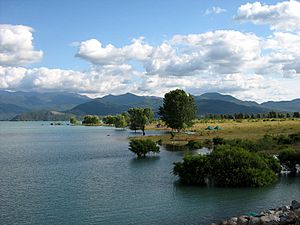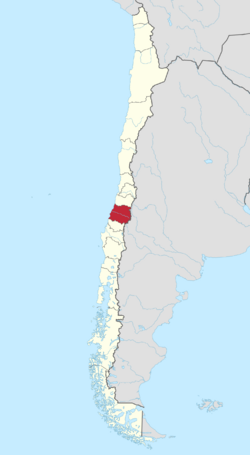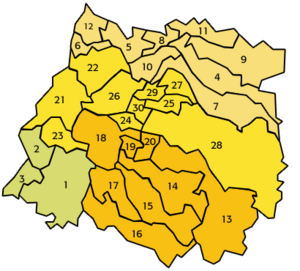Maule Region facts for kids
Quick facts for kids
Maule Region
Región del Maule
|
|||
|---|---|---|---|

Colbún Lake
|
|||
|
|||

Map of Maule Region
|
|||
| Country | |||
| Capital | Talca | ||
| Provinces | Curicó, Talca, Linares, Cauquenes | ||
| Area | |||
| • Total | 30,296.1 km2 (11,697.4 sq mi) | ||
| Area rank | 9 | ||
| Lowest elevation | 0 m (0 ft) | ||
| Population
(2017 census)
|
|||
| • Total | 1,033,197 | ||
| • Rank | 4 | ||
| • Density | 34.10330/km2 (88.32714/sq mi) | ||
| GDP (PPP) | |||
| • Total | $10.998 billion (2014) | ||
| • Per capita | $10,620 (2014) | ||
| ISO 3166 code | CL-ML | ||
| HDI (2019) | 0.790 high |
||
| Website | Official website: http://www.gobiernoregionaldelmaule.cl/ | ||
The Maule Region (called Región del Maule in Spanish) is one of Chile's 16 main areas. Its capital city is Talca. The region gets its name from the Maule River. This river flows from the Andes mountains and cuts through the region. It was very important in history because it marked the southern border of the Inca Empire.
Contents
Geography and Nature
The Maule Region covers about 30,296 square kilometers (11,697 square miles). To the west, it touches the Pacific Ocean. To the east, it borders Argentina. The O'Higgins Region is to its north, and the Ñuble Region is to its south.
The land here changes a lot from west to east. You'll find the Pacific coast, then the Chilean Coast Range (a mountain range). After that, there's a part of the Chilean Central Valley, and finally, the Andes mountains.
Plants and Animals of Maule
The Maule Region is home to many different plants and animals. For example, the endangered Chilean wine palm (Jubaea chilensis) grows in only a few places, including Maule. Two other rare and endangered trees, Nothofagus alessandrii and Gomortega keule, also live here.
There are several special areas in the region that protect nature. These include Altos de Lircay National Reserve, Federico Albert National Reserve, Laguna Torca National Reserve, Los Bellotos del Melado National Reserve, Los Queules National Reserve, Los Ruiles National Reserve, and Radal Siete Tazas National Park.
People of Maule
According to the 2017 census, about 1,033,197 people live in the Maule Region. About one-third of these people live in rural areas. This means Maule has more people living in the countryside than any other region in Chile.
Main Cities and Towns
The biggest city is Talca, which is also the capital. It has about 235,000 people. Other important cities include Curicó (120,700 people) and Linares (127,000 people). Smaller but still important towns are Constitución (50,914), Parral (47,000), Cauquenes (43,000), Molina (42,000), and San Javier (40,000).
Population Facts
The Maule Region has about 34 people per square kilometer. Areas closer to the mountains are less crowded, while the central valley is more densely populated.
The number of young people (under 15) is growing faster than the adult population. The region's population grows by about 1.06% each year. This is a bit low because fewer babies are being born. On average, people in Maule live to be about 76.3 years old.
Economy and Jobs
The main ways people make money in Maule are through forestry (working with trees) and agriculture (farming). Growing grapes for wine is a very big part of the economy.
Wine Production
The Maule Region is Chile's top wine-making area. It produces half of all the fine wines Chile exports to other countries. Many of the largest vineyards are located here. The Curicó Valley is known as the heart of Chile's wine industry. The name "Curicó" means "black water" in the Mapudungun language. Wine-making has been a tradition here since the 1830s. As more grapes are grown, the wine industry also grows with new technology and equipment.
Other Farm Products
Besides wine, farmers also grow fruits, vegetables, and flowers. These products are often sold to other countries.
Energy and Water
Providing electricity, gas, and water is another important economic activity. The Maule River helps power five hydroelectric plants. These include the large Colbún-Machicura complex.
How Maule is Governed
The Maule Region is divided into four provinces. These provinces are then split into 30 smaller areas called communes.
| Political and administrative divisions of Maule Region, Chile |
- Cauquenes Province has 3 communes. Its capital is Cauquenes.
- Curicó Province has 9 communes. Its capital is Curicó.
- Linares Province has 8 communes. Its capital is Linares.
- Talca Province has 10 communes. Its capital is Talca.
History of Maule
Rich Heritage
The Maule Region has been home to many famous people. These include writers, poets, statesmen, presidents, scientists, and musicians. The Maule River is often called Chile's "literary river." Many stories and novels have been set along its banks. The region is known for its rich cultural history.
Many small towns and villages in Maule have old buildings with beautiful colonial architecture. This includes both religious buildings, like parish churches, and regular homes. The Talca and Linares dioceses (Catholic church areas) have several churches that are very old and beautiful.
The 2010 Earthquake
On February 27, 2010, a very strong 8.8 magnitude earthquake hit off the coast of Maule. It happened near Curanipe and Concepción. The earthquake lasted almost four minutes and caused a lot of damage. A large tsunami (giant wave) followed, making things even worse.
The cities of Cauquenes and Constitución were badly damaged by the earthquake and tsunami. It was impossible to get electricity back on in these cities right away because of the damage.
Images for kids
-
Cathedral San Ambrosio, Linares.
-
Bride's Veil Waterfall, in Molina.
-
Siete Tazas waterfalls, in Molina.
-
Thermal baths in Panimávida.
-
Talca's main commercial street.
-
Parish church of the village of Nirivilo.
See also
 In Spanish: Región del Maule para niños
In Spanish: Región del Maule para niños
- Ranked list of Chilean regions
- Founding of Talca
- Juan de la Cruz y Bernardotte
- Juan Albano Pereira Márquez










